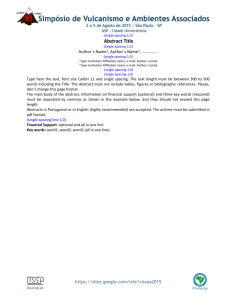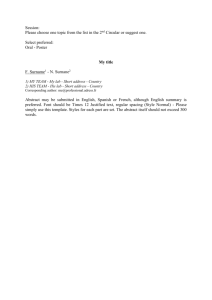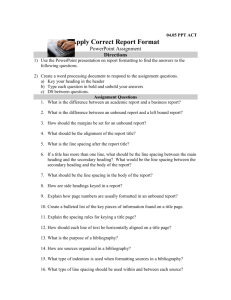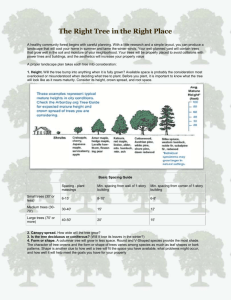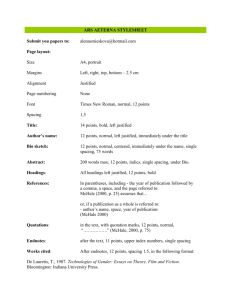IJ
advertisement
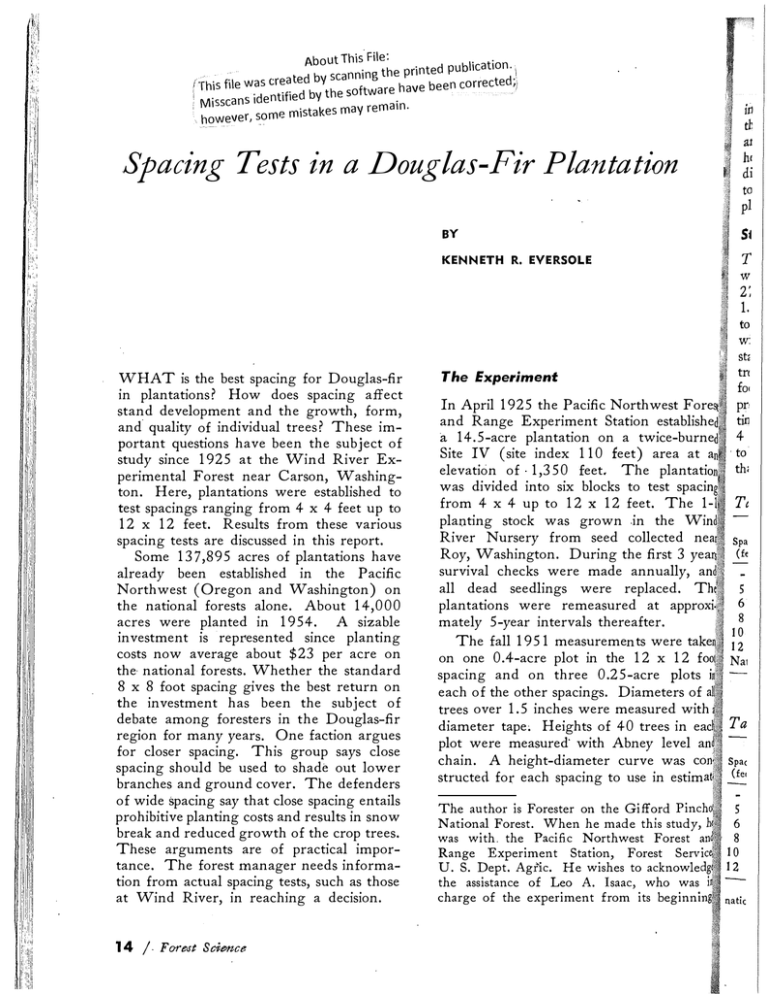
' File: About This . ati.on. \ public the printed ng . nni ' sca by ted a . d'J cre . This file was been correcte ,I e . hav are softw ntified by the I Mi. sscans. 'de ay remain. m me mistakes however, so in tb at Spacing Tests in a Douglas-Fir Plantation hI di to pI BY s KENNETH R. EVERSOLE T w 2: 1. to w: st WHAT is the best spacing for Douglas-fir in plantations? How does spacing affect stand development and the growth, form, and' quality of individual trees? These im­ portant questions have been the subject of study since 1925 at the Wind River Ex­ perimental Forest near Carson, Washing­ ton. Here, plantations were established to test spacings ranging from 4 x 4 feet up to 12 x 12 feet. Results from these various spacing tests are discussed in this report. Some 137,895 acres of plantations have already been established in the Pacific Northwest (Oregon and Washington) on the national forests alone. About 14,000 acres were planted in 1954. A sizable investment is repJ:1esented since planting costs now average about $23 per acre on the- national forests. Whether the standard 8 x 8 foot spacing gives the best return on the investment has been the subject of debate among foresters in the Douglas-fir region for many years. One faction argues for closer spacing. This group says close spacing should be used to shade out lower branches and ground cover. The defenders of wide spacing say that close spacing entails prohibitive planting costs and results in snow break and reduced growth of the crop trees. These arguments are of practical impor­ tance. The forest manager needs informa­ tion from actual spacing tests, such as those at Wind River, in reaching a decision. 14 j. Forest Science The Experiment In April 1925 the Pacific Northwest Fores and Range Experiment Station establishe a 14.5-acre plantation on a twice-burne Site IV (site index 1 10 feet) area at a elevation of 1,350 feet. The plantatio was divided into six blocks to test spacin from 4 x 4 up to 12 x 12 feet. The 1-1 planting stock was grown .in the Wind River Nursery from seed collected near Roy, Washington. During the first 3 year survival checks were made annually, and all dead seedlings were replaced. The plantations were remeasured at approxi mately 5-year intervals thereafter. The fall 195 1 measuremen ts were take on one 0 A-acre plot in the 12 x 12 fa spacing and on three 0.25-acre plots i each of the other spacings. Diameters of a trees over 1.5 inches were measured with diameter tape Heights of 40 trees in eac plot were measured with Abney level a chain. A height-diameter curve was co ' structed. fot; each spacing to use in estimat The author is Forester on the Gifford Pinch National Forest. When he made this study, was with, the Pacific Northwest Forest an Range Experiment Station, Forest Servi U. S. Dept. Agnc. He wishes to acknowled the assistance of Leo A. Isaac, who was charge of the experiment from its beginnin trt fOI pr j till 4 to th; Tt Spa (fe ­ 5 6 8 10 12 Nal Ta Spa( (fel ­ 5 6 8 10 12 natic ing volumes. On each plot the diameter of the tree with average basal area (dominant and codominant stand) was calculated. The height of this tree was read from the height­ diameter curve for each spacing and used to estimate site' index. The time since planting was used as the age. n most volume of large products (Fig. 1) The total-stem cubic volume in the close spacings is distributed on many small stems. Many of these will soon die. Statistics from a nearby natural stand are similar to the 8 x 8 spacing. • Growth and mortality. Periodic annual growth and mortality (Table 2) show how the plantation has changed during the most recent remeasurement period. The variation in total-stem cubic volume growth does not appear to be associated with spacing at this ' a ge. Judging by evidence on the ground, the variation is apparently associated with slight differences in site quality. The trend' of board-foot volume growth is exaggerated by the heavier ingrowth in the wide spac­ ings. Even so, the wide spacings are well ahead in board-foot production. Natural thinning is beginning in the 4 x 4-foot spacing, but the death of suppressed trees will probably do little toward releasing the crop trees. Stand Development Several trends associated The live stand. with spacing are evident in statistics for the 27-year-old plantation (Table 1). In trees 1.5 inches d.b.h. and larger, basal area and . total-stem cubic volume decreased with wider spacing. On the other hand, in the stand 6.6 inches d.b.h. and larger, this trend was reversed in basal area and board­ foot volume. Indeed, the 6,070 board feet produced by the 12 x 12 spacing is many times greater than the 268 board feet in the ­ x 4 spacing. Ingrowth soon will tend . to level off this difference, but it is evident that the wide spacings have produced the st Fore tablishe -burne a at a [antatio spacm Table ·1. 1951 statistics of the live stand for each spacing) acre basis rhe I­ e Win Spacing (feet) Stand 1.5 inches and over Number. of trees Basal area (sq. ft.) Volume (cu.ft.) ­ X 45 X 5 1,830 132.0 1,4-80 112.8 2 320 ) 1,890 6 1,030 103.8 1,870 580 78.6 405 91.2 .287 80.5 75.5 X 6 8 x 8 10 X 10 12 X 12 Natura12 598 Number of trees Stand 6.6 inches and over Volume (eu.ft.) Basal area (sq. ft.) Volume! (bd. ft.) 8 2.4- 61 6 1.5 34 137 8.6 191 753 '1,470 30 67 19.8 425 1,950 166 57.7 1,282 5,500 1,740 176 65.4- 1,4-60 6,070 1,44-0 98 35.7 778 3,190 268 1,690. lInternational liS-inch rule. 2Data from a nearby natural stand of the same age. T able 2. Periodic annual growth and mortality) 1945-1951) acre basis Spacing (feet) - Pinch udy, h' 'est an::l Service owledge . . was l rinning: ) ' t Basal area (sq. ft.) Annual growth (cu. ft.) Volume! (bd. ft.) Number of trees Annual mortality Basal area (sq. ft.) Volume! (cu. ft.) 4- X 4 5 X 5 6.15 6.26 176.8 45 24-.7 0.84 156.4- 23 5.7 0.15 1.6 6 5:93 157.1 126 5.0 0.17 2.2 x 6 8 X 8 10 12 11.6 5.4-0 138.4- 198 1.0 0.02 0.2 X 10 6.87 193.6 820 0.7 0.03 0.4- X 12 5.85 167.7 853 1.0 0.13 .2.3 --- lCubie volume for trees 1.5 inches and over i nation al 1 IS-inch rule. board-foot volume for trees 6.6 inches and over, vol. 1, no. by Inter­ 1, 1955 / 15 Height domina? dence t: th e ave domina: w as as In ge greater nant a: spacin& spacin§ Fig. 1. Effect at spacing on tree size in a 27-year-old plantation at Douglas-fir. Trees are same age and have grown under approximately the same conditions in both spacings. (Left) 4 x foot spacing where trees average 3.6 inches in diamCiter and 33.7 fu't in height. (Right) 12 x 1 foot spacmg, trees average 7.2 1;'11Jches in diameter and 46.2 feet in height. Normality. The effect of spacing on tree height has affected site determination sig­ nificantly. Therefore, in computing stand normality for the various spacings, a site index of 1 10 feet, from the nearby natural stand, was used. Normality for the differ­ ent spacings computed for the conventional measures was as tabulated below. Number of trees Spacing Cubic volume Percent Percent 4- 5 6 8 10 12 X X X X X X 45 6 8 10 12 9476 53 30 21 15 125 102 101 80 106 9­ Board - foot volume (Interna'tionaZ 1/8-inch rule) Percent 16 8 4-5 100 327 361 Even though the wide spacings were far below normal in number of stems at age 27 years, they were near normal in total-stem cubic volume and, far above normal in board-foot volume. 16 / ForelSt Science The Average Tree H eight and diameter. erage tree increased with wider sp (Fig. 2). The average tree in the 12­ 12-foot spacing was twice the diameter the average tree in the ­ x ­ spacing and' was 12.5 feet taller'­ When the plantation . was only 5 years old, the trees in the ­ x .. and 5 x 5 spacings were taller than in the wider spacings.1 By the time the were 10 years old this trend was and the difference in height has steadily ever since. Average diameter followed a similar trend. During the recent growth period, average diameter the 4- x 4- spacing increased only 0.6 During the same period, average in the 12 x 12 spacing increased 1.9 HE\( ( feE 4 1Isaac, Leo A. 1937. 1 0 years' growth Douglas-fir spacing-test plantations. Pacif. west For. Range Exp. Sta. Res. Note No. 23, OJ (incl 'way for these two plantings, the difference in predicted yields in a laO-year r<?tation is about 19,000 board feet, Scribner volume. Height of the average dominant and co­ dominant. The spacing test provides evi­ dence that density has a marked effect on the average height of dominant and co­ dominant trees. After 27 years the trend was as follows: Height o f t1fVerage dominant and codominrmt (feet) Spacing (feet) 4- X 4- 38. 1 5 X 5 35.2 6 X 6 38.7 8 X 8 39.9 10 X 10 4-6.3 12 X 12 4-8.4- In general, wider spacing resulted in greater height growth. The average domi­ nant and codominant in the 12- x 12-foot spacing was 10 feet taller than in the 4 x 4 spacing. If site is calculated in the accepted This wide difference in indicated pro­ ductivity does not seem reasonable for a planting area that is fairly uniform.· The analysis casts doubt on the use of the height of the average dominant and codominant tree as a true index of site quality in young-growth stands. The codominants, at least, are strongly affected by spacing. There is an almost step-like break in the codominant crown level from the 4 x 4 spacing into the lO x 10 spacing. This break is very apparent when looking from an elevated vantage point in the 4 x 4 plantation. Would the heights of the tallest domi­ nants alone be a better measure of site 46.2 447 35.0 10 D.B.H. (inches) SPACING (feet) o. 2 4x4 5x5 6x6 8x8 IOx lO 12xl2 Natural Fig. 2. Height and diameter of the average tree in each spacing at age 27 years. vot. 1, no. 1, 1955 / 17 quality? That they may be is indicated by calculating site index2 from the average heights of the 6 tallest dominants on adja­ cent plots in the 4 x 4 spacing and the 10 x 10 spacing: Spacing (feet) 4 x 4 10 x 10 Site index using height of average domincmt and co­ dominant in 1951 (feet) Site index using average height of 6 tallest dominants in 1953 (feet) 100 120 125 137 Site index calCulated from the average height of the 6 tallest dominants on a 0.25­ acre plot is apparently less affected by spacing than site index measured in the usual way. Limb size and height to live crown. The effect of spacing on limb size is often stressed.3 In 195 1 40 trees in each spac­ ing were measured for limb size and height to live crown. Limb size was taken as the average of the 2 largest limbs in the whorl above and the whorl below d.b.h., mea­ sured 1 inch from the trunk. A tabulation of results follows: Spacing (feet) 4 5 6 8 10 12 X X X X X X 4 5 6 8 10 12 Limb size (inch ) 0.36 .43 ,48 .54 .73 .73 H eight to live crown (feet) 19.5 13.7 10.7 8.9 8,4 6.7 An increase in limb size with wider spac­ ing is apparent, but even the large limbs in the 12- x 12-foot spacing averaged less than three-fourths inch. These limbs are dead and will not make fur-ther growth. 2Staebler, George R. 1948. Use of dominant tree heights in determining site index for Douglas-fir. Paci£. Nthwest For. Range Exp. Sta. Res. Note No. 44. 3M unger, T. T. 1946. The spacing in plan­ tations. Pacific Nthwest For. Range Exp. Sta. Res. Note No. 34. 18 / Forcut Sc ence The limbs in the close spacings are sma but even in the 4 x 4 spacing little de wood will be produced in a 100-year rot tion without artificial pruning.4 Conclusions Records from the 27-year-old spacin test plantation of Douglas-fir indicate tha 1. Wide spacmg m plantations h little effect on total-stem cubic volume i the first 27 years, but increases board-fo volume greatly. 2. Average diameter is greatly increa se by wide spacing. 3. Wide spacing produces a taller dam inant and codominant stand (and a high site index when measured in the conve tional way). 4. Average limb size is increased wide spacing. The findings should prove useful to t forest manager in deciding what spacing use under a given set of conditions and o. jectives. His problem is to balance plantin costs against estimated future retur Planting costs per tree will be nearly t same regardless of spacing. Therefore, t wider the spacing (up to 12 x 12 feet 0 Site IV land), the lower the initial cost a the sooner material of sawlog size will produced. Since, even in close spacin pruning will be necessary to produce cle lumber in 80 - 100-year rotations, it may best .to keep planting costs low by spacin trees as far apart as 10 feet, with the e pectation of pruning at an early age. If 12-foot spacing is used, careful plantin and early replacements may be necessary avoid large openings. In contrast, whe very early thinnings for small pole-si material are anticipated, closer spacin would be desirable. 4Kachin, Theodore. 1940. Natural pruni in second-growth Douglas-fir. Paci£. Nthwe For. Range Exp. Sta. Res. Note No. 31. G a D' de pit dt L: trl se. ar pr te ar SH L 1< h F c r a 1
